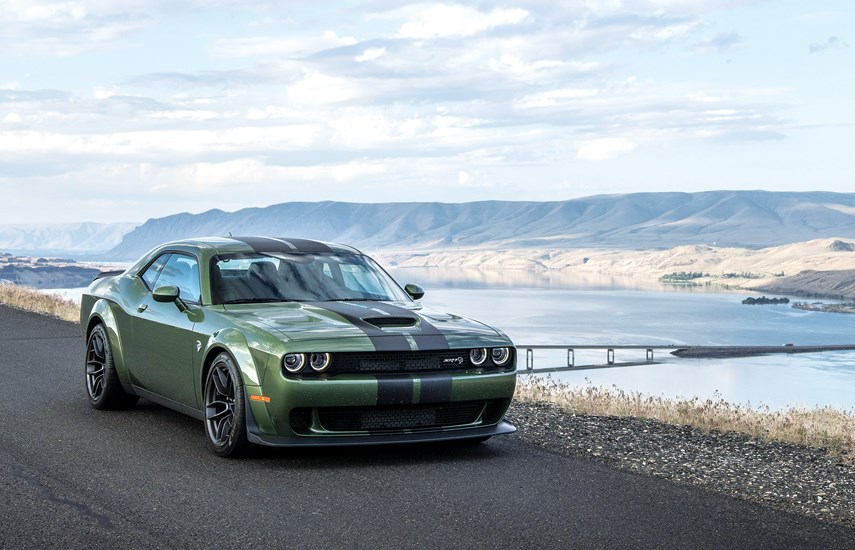A biweekly round-up of automotive news, good, bad and just plain weird:
Dodge has put 500 million horsepower on the road since 2014
If it sometimes feels like we’re drowning in a sea of horsepower these days, then Dodge has just put a figure to the madness. Instead of measuring sales results by cars sold, they’ve been adding up how much power each registered Challenger, Charger, and Durango made.
There’s more, too. Discovering some time back that the total was a hefty 485 million horsepower, Dodge’s marketing team hit on a genius plan. Why not offer horsepower-related discounts? In the U.S., you could get $10 off per horsepower.
Buy a Challenger Hellcat? That’s $7,070 off the pricetag. Opt for the V-6 version instead? Well, you won’t be getting quite as good of a price.
Now obviously there’s a part of me that realizes that incentivizing people to buy powerful cars is not the greatest idea anyone has ever had. More horsepower on the road means more gallons of gas consumed, and then there’s the whole public safety issue.
However, gasoline is expensive, and it’s taxed. Further, what’s more dangerous – somebody cruising to a cars and coffee in their dream muscle car, or someone rushing to work on a Monday in their four-cylinder crossover, while texting?
Still, while you can’t argue with Dodge’s sales results, I can make the case against their methods. Were it up to me, I wouldn’t offer dollars off for buying a more powerful car, I’d apply those discounts towards a proper driver training experience. Buy a V-6 Challenger? You’re probably OK. Buying a Hellcat? Well, we’re going to fly you to Bondurant racing school and teach you how to be responsible for that much power.
Hyundai builds 400 h.p. drift van
Going directly from calling for reasonable and prudent operation of motor vehicles to praising a bunch of Australian lunatics getting sideways in an overpowered minivan seems like a bit of a reach. But don’t worry. I’ve been doing yoga.
Meet the Hyundai iMax N, an eight-passenger minivan with a twin-turbo V-6 stuffed under its hood and a welded rear differential out back. The incredibly silly brainchild of Hyundai’s Australian team, the iMax N is the result of an internet poll (what else) that asked the public what would be the ideal next vehicle from Hyundai to get the N treatment.
N is Hyundai’s performance division, and it’s available here in the person of the Veloster N. The Veloster N was one of my favourite cars tested this year, but I can assure you that I would happily have swapped it for a huge blue van that does enormous burnouts.
That is because I am a child, and should not be allowed to have things like this. Which sort of ties us back in with the whole Dodge education idea.
Tesla continues to push Model S at the Nurburgring
Seeing as this week is all about silly levels of horsepower and vehicles that look like they were designed by someone who’d eaten half a box of crayons, let’s see how Tesla’s Nurburgring experiment is going. As you may remember, Porsche’s launch of the Taycan EV sedan included much boasting about Stuttgart’s advantages in tuning cars to handle. Tesla’s been fighting back.
On one hand, the Model S that’s been turning laps at the Nurburgring is a total cheat. It has wide tires, ceramic brakes, fender flares, and now giant wings that aren’t available on any Tesla product. It also appears to have had its entire interior stripped out, to the point that the door handles don’t work.
To this I say: who cares? Yes, Tesla’s attention might be better spent trying to produce cars with consistent quality control and at a reliable profit for longevity, but having a small team tilting at Porsche for bragging rights seems worth cheering for. It’s a welcome break from exaggerating the autonomous abilities of Tesla’s so-called Autopilot, and is just plain fun.
Electric turbochargers are here
To round things out, let’s mix a little high-horsepower fizz with some electrification news. At long last, turbocharger specialist Garrett is announcing that they’ve successfully tested an electric turbocharger, and that the technology will be available in a production car by 2021.
As a quick refresher, here’s how a turbo charger works. Exhaust gasses exit the combustion chamber hot and fast, and that energy normally just dissipates. With a turbocharger, you use those gasses to drive a fan, then use a shaft to connect that fan to a cool-side fan that pressurizes the combustion chamber. Add a little extra fuel, and you get a bigger explosion – and more power.
The problem is managing everything to burn cleanly and safely, something engineers have been working on for ages. What Garrett has done with their new electric turbocharger is add in a small electric motor that assists the fan when exhaust flow is low. You may have heard people talking about “turbo-lag,” which is the time it takes to spin up the fans and start forcing air into the engine. This electrified turbocharger eliminates it.
What does that mean for production cars? Well, turbocharger size is a restriction for most applications. Bigger turbochargers flow more air and make more power, but they are slower to spool up and start making that power. With this hybrid Garrett, you’d be able to run a bigger turbocharger on a smaller engine, and also more tightly control the process for cleaner burning.
Making a kitten-sized engine that can pump out Hellcat power levels when called upon? That’s just what the future of electric turbocharging might look like.
Watch this space for all the best and worst of automotive news, or submit your own auto oddities to [email protected].



